As mentioned in the constitution, India is a republic country that mandates the periodic election of the president who is head of state.
A democratic polity can be Monarchy or Republic.
| Monarchy | Republic |
| Head of state (King or queen) | The head of the state is always elected. |
| Enjoys the hereditary position. | Elected |
| England | USA, INDIA |
To have better clarity following steps needs to be followed:-
- Who participates in the election.
- Direct and indirect election.
- Value of MLA(Member of the legislative assembly of state) vote.
- Value of MP(Member of parliament both lower and upper house) vote.
- Voting process.
Who participates in the election?
- The elected members of the parliament participate in the election(Loksabha and Rajya sabha). For example, Shri Sachin Tendulkar cannot join because he is a nominated member of Rajya sabha. Nominated members cannot vote while selecting the President.
- The elected members of legislative assemblies of states participate in the election. Members of the legislative council of the state cannot participate.
- The elected members of legislative assemblies of UT of Delhi and Puducherry participate in the election.
Direct and indirect election
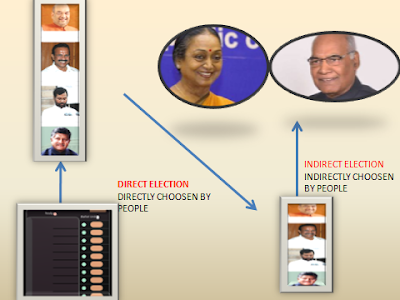
The people do not directly elect President. Elected representatives of parliament and state legislature elect the President. Therefore the presidential election is called an indirect election.
Value of MLA(Member of the legislative assembly of state) vote
- In the general election, every eligible citizen has a single transferable vote value, but this is not the case for the president’s election.
- The value of each MLA vote is the result of dividing A by B.(A and B mentioned below)
A>The total population of the state as per the 1971 census.
B>Product of the number of seats in the state assembly and 1000.


Value of MP(Member of parliament both lower and upper house) vote
The value of the MP vote is the result of dividing A by B.
A> The total value of all MLA votes.
B> The total no of seats in both houses of the parliament.

MP-Member of parliament
MLA-Member of the legislative assembly
LS-Loksabha(lower house/house of people)
RS-Rajya sabha(Upper house/Council of states)
Voting process
Everyone cannot stand for the post of President. You need at least 50 electors as proposers (People supporting your candidature for president post) and 50 electors as seconders(People supporting proposer decision to help you).
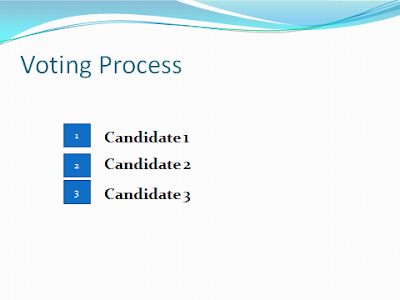
Each eligible voter gets a Ballot paper where they have to give their vote based on preference. Ballot paper contains the name of all candidates. The voter has to mention which candidate is their first choice, second, and so on.

Telangana State only, in reality, all state and UT will vote
No of MP who are participating=100
No of MLA participating=100(Telangana)
To understand the voting process let us consider three candidates who are fighting for the post of president.
SCENARIO 1:-WHEN CANDIDATE WIN IN FIRST ROUND OF COUNTING
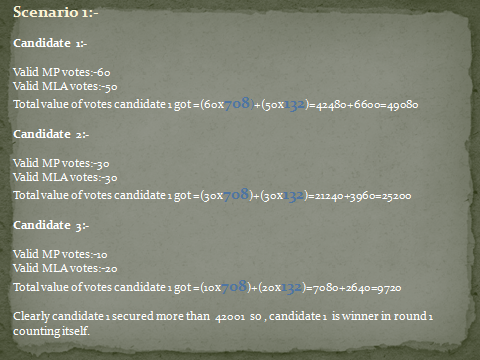
itself but there might be a situation when no candidate crosses
half mark for winning in that scenario second round of counting will occur.
708-value of MP vote
132-value of MLA vote
SCENARIO 2:-WHEN CANDIDATE WIN IN SECOND ROUND OF COUNTING
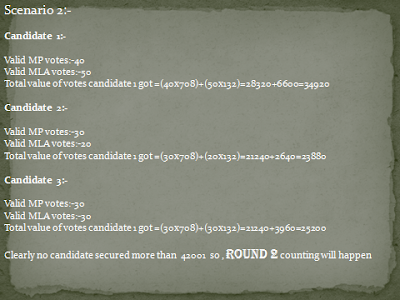
If no candidate crosses the halfway mark as depicted in scenario 2, round 2 counting starts. The vote value of the candidate securing the least is divided. The division is done based on their second preference.
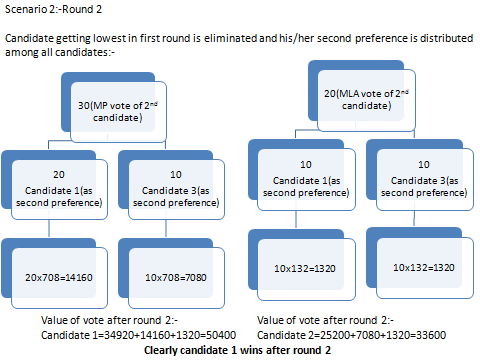
Candidate 1 gets 14160 MP vote value from candidate 2 and 1320 MLA vote value from candidate 2.
If no candidate crossed the halfway mark after the 2nd round of counting, then the 3rd round of counting will happen. This process will continue until one candidate secures a majority.
Also read:-Strong public Institutions for flourishing democracy



thank you for share such type of valuable knowledge . I have gain knowledge for my career.